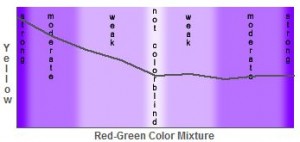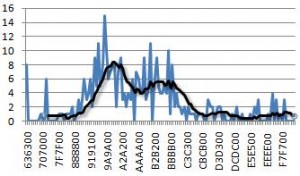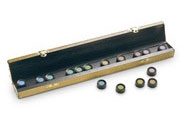Ever tried to make your own Ishihara plates test? Alon has the answer for all of us who are not that inventive or at least not good with computer programs.

Which number do you see?
Photo taken by Alon Salant.
Ever tried to make your own Ishihara plates test? Alon has the answer for all of us who are not that inventive or at least not good with computer programs.

Which number do you see?
Photo taken by Alon Salant.

A few weeks ago I released the new RGB Anomaloscope. A slight adjustment was introduced since the first release and I also added a little survey to make it more accurate. Now I’m happy to announce the severity upgrade of the RGB Anomaloscope color blindness test.
The diagram is now split into several colored areas. As your personal matching line starts growing from the center it is possible to find the severity of your red-green color blindness. A very short line in the center means you are not colorblind, compared to a line stretching along the whole diagram which means you are suffering from a strong color blindness.

This update was based on more than 1’000 color blindness tests taken so far.I hope this helps you to find out more about your color vision.
I also checked the resulting matching points and found some interesting facts. The diagram to the side shows the colors which were matched with red.
The interesting fact is, that there are two main areas which can be identified. This points towards a possible differentiation of red- and green-blindness.
Before I release another upgrade including also the type of red-green color blindness I would like to gather some more test data. So stay tuned for a future release of the RGB Anomaloscope.
There are different tests available to check your color vision. Unfortunately they can’t be easily compared one to each other. This yields to the question, can you pass one sort of color blindness tests while failing on other ones?
Have you ever heard of somebody who can pass the D-15 test, but can’t pass an Ishihara plate test? I’ve been told I was colorblind (for 20 years) because I can’t see all the numbers in the bubbles. I finally asked my optometrist what type of colorblind I was (out of curiosity) and he gave me the D-15 test to find out. I passed it with flying colors—all in the correct order.
My optometrist has never seen somebody pass the D-15 and fail the Ishihara (he gave me that as well…). Any ideas?
A very important but in some way hidden message in this question is, that you have to go to your optometrist for a reliable check of your color vision. Online color blindness tests are a good start but not the right tool to get secure test results.
The most common color blindness tests can be arranged into four main categories. In each of those categories are many different types of tests available, whereas the system of the test stays the same.

When you read through the list above you can easily guess that all those different color blindness tests can’t have the same sensitivity. Some are very sensitive like pseudoisochromatic plates. They are sometimes even not readable for people with normal color vision. On the other side the lantern tests are best to check if you are fit to do certain jobs and are not checking if you are only slightly colorblind.
To conclude: you can easily fail an Ishihara plates tests and pass a D-15 arrangement test at the same time. I would say many people with a low to moderate color blindness will receive such a test result.
What I don’t understand is why your optometrist was astonished by your test results…